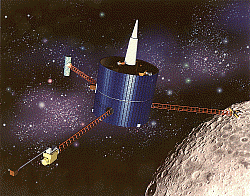Why colonise the moon?
Demand for Earth's resources to sustain human progress is quickly placing a crippling burden on the planet. It only makes sense to use the many resources on our nearest neighbours, namely the moon and Mars. Firstly lets look at the moon.
The moon is an ideal place to set up a permanent base. We can mine its many minerals and use it as a research and training ground for launching missions to Mars. We can perfect the many techniques for living on other planets on our closest neighbour before we venture on a longer and riskier journey to Mars. With no atmosphere the surface of the Moon is exposed to vacuum. In direct sunlight temperatures climb to 120 oC while in the shade remain below -173 oC . Any gas that may have existed is now long gone as the moon's gravity, being one sixth that of Earth's, is not strong enough to trap it.
Before we can colonise the Moon we need precious water. The cost of transporting water to the Moon is prohibitive at between $2,000 and $20,000 per litre. NASA has conducted missions to investigate the presence of water on or near the surface.
One
of these Discovery missions involved the Lunar Prospector, pictured on
the right. Although tests conducted by the Lunar Prospector are not conclusive,
initial data indicates that ice may be present in permanently dark craters
at the poles of the Moon. Scientists suspect that water may have been
brought onto the Moon by meteorites which relentlessly bombarded the surface
over the past 3-4 billion years.
Water is a priceless commodity for reasons such as:
- the need for re-hydration, preparation of meals
and hygiene.
- the extraction of hydrogen and oxygen. Oxygen for astronauts to breath
and hydrogen as a fuel to power rockets to other planets, such as Mars,
or as an energy source for the Lunar colony.
- developing a sustainable food source.
Not only does the Moon have places of perpetual darkness but also a place of almost endless daylight at the south pole. This makes the acquisition of electricity from solar energy a viable alternative.

The Lunar Prospector entered Moon orbit in January 1998
Demo - Electrolysis of water and the
use of water as a source of energy.
Why is the
Moon covered in craters?
Why do
we suspect that water exists only in dark craters?
If water was once present , unlike the surface of the Earth, why is the
surface of the Moon now dry?
Why is the moon and not the Earth an ideal launch platform for missions
to Mars?